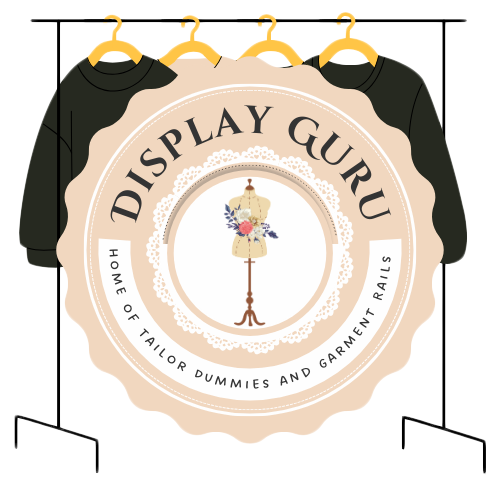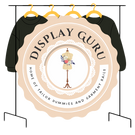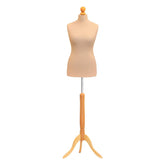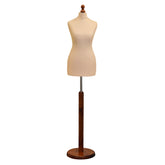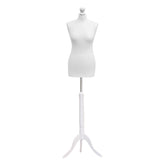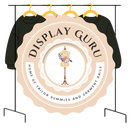Mannequin Measurements: Accurate Size Charts for Fashion
When we talk about standard mannequin measurements, the go-to reference in the UK is a female size 8/10. For this industry staple, you're typically looking at a bust of around 88 cm (34.5 inches), a waist of 65 cm (25.5 inches), and hips measuring 90 cm (35.5 inches). These specific dimensions are far more than just numbers; they form a critical baseline for designers, retailers, and visual merchandisers, ensuring that garments fit and display just as they were intended.
Why Accurate Mannequin Measurements Matter
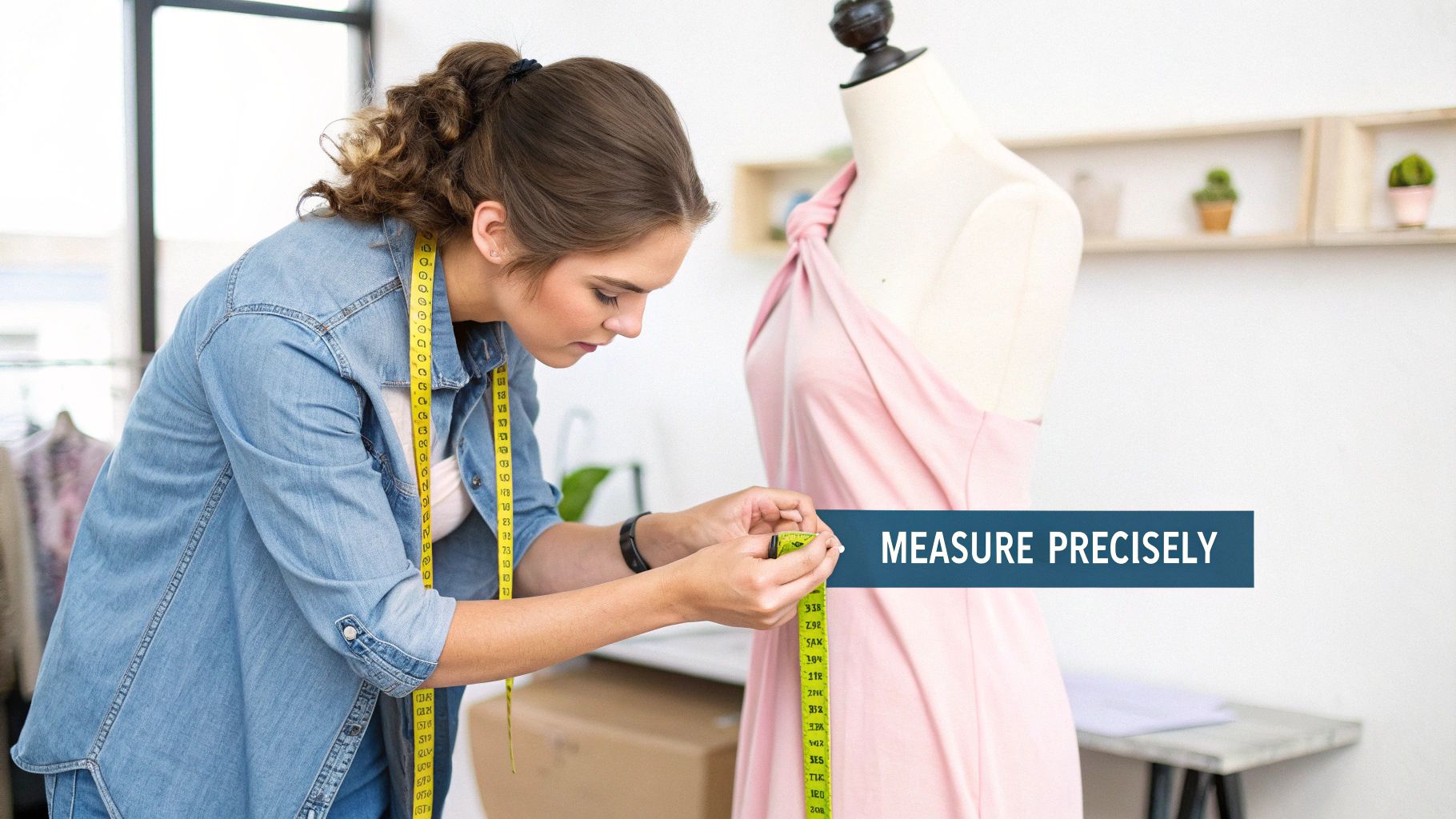
Anyone working in fashion quickly learns that understanding standard mannequin measurements is absolutely fundamental. These dimensions aren't arbitrary. They represent the crucial link between a designer's creative vision and how a customer experiences the final product. For retailers, having mannequins that genuinely reflect their target demographic's sizing can be the difference between a sale and a return.
When the dimensions are right, clothing hangs and drapes correctly, which brings the intended fit and subtle design details to the forefront. This is non-negotiable for everything from a high-street window display to the product shots on an e-commerce website. Without a reliable, standardised measurement system, a brand's presentation can become inconsistent, creating a disconnect with the very people it's trying to reach.
The Foundation for Garment Design and Display
The most frequently encountered mannequin in the UK fashion scene is, without a doubt, the female size 8/10. This particular size serves as a universal starting point for creating patterns, fitting initial samples, and showcasing new collections. But the world of mannequins is much broader than this single standard.
It’s helpful to think of them in a few key categories:
- Female Mannequins: While the standard is a UK size 8 to 12, the market also includes specialised petite and plus-size models to cater to a wider audience.
- Male Mannequins: The industry benchmark here is often a '40R', which translates to a 40-inch chest.
- Child Mannequins: These are sized according to specific age groups, covering everything from toddlers to teenagers to accurately reflect different stages of growth.
To provide a quick and useful overview, the table below summarises the most common measurements you'll find for a standard female mannequin.
For a designer or visual merchandiser, a mannequin is never just a prop. It's the silent salesperson, the first physical interaction a potential customer has with a garment. Its measurements have to be spot on.
Quick Reference Mannequin Measurements (Standard UK Female Size 8/10)
This quick-lookup table lays out the essential dimensions for a standard UK size 8/10 female fashion mannequin. These are the industry’s go-to figures for general apparel fitting and display.
| Measurement Point | Typical Measurement (cm) | Typical Measurement (inches) |
|---|---|---|
| Height | 175 - 180 cm | 69" - 71" |
| Bust | 88 cm | 34.5" |
| Waist | 65 cm | 25.5" |
| Hips | 90 cm | 35.5" |
| Shoulder Width | 40 cm | 15.5" |
Having these measurements handy is invaluable, whether you're sourcing new mannequins for a store refresh or fitting a new clothing line in the studio.
How to Measure a Mannequin Accurately
Getting accurate, repeatable measurements from your mannequins is a cornerstone of professional garment design and retail display. While a mannequin's static form makes it easier to measure than a person, you still need a consistent method to get it right every time. The right technique ensures your garments hang perfectly and provides a true-to-form standard for your entire collection.
First things first, you'll need the right tool for the job. A flexible, non-stretch tailor’s tape measure is non-negotiable. A rigid metal one simply won't wrap around the body's curves, giving you flawed numbers. When you measure, pull the tape snug against the mannequin, but not so tight that it digs in—this is especially important with softer polystyrene forms where you could easily create a dent.
Key Measurement Points and Techniques
To ensure your measurements are consistent across all your forms, you need to measure from the same anatomical points every single time. The golden rule for circumference measurements like the bust, waist, and hips is to keep the tape measure perfectly parallel to the floor. If the tape is angled, even slightly, you can accidentally add centimetres and throw off your fit.
- Bust: You’ll want to measure around the very fullest part of the chest. Make sure the tape goes directly over the apex (the most prominent point of the bust) and stays completely level across the back.
- Waist: Locate the natural waistline, which is simply the narrowest part of the torso. Wrap your tape around this point, keeping it straight and parallel to the floor.
- Hips: This measurement is taken around the widest point of the hips and buttocks. Just like the others, a level tape is absolutely crucial for an accurate reading here.
This visual guide breaks down the core measurements for the upper body.
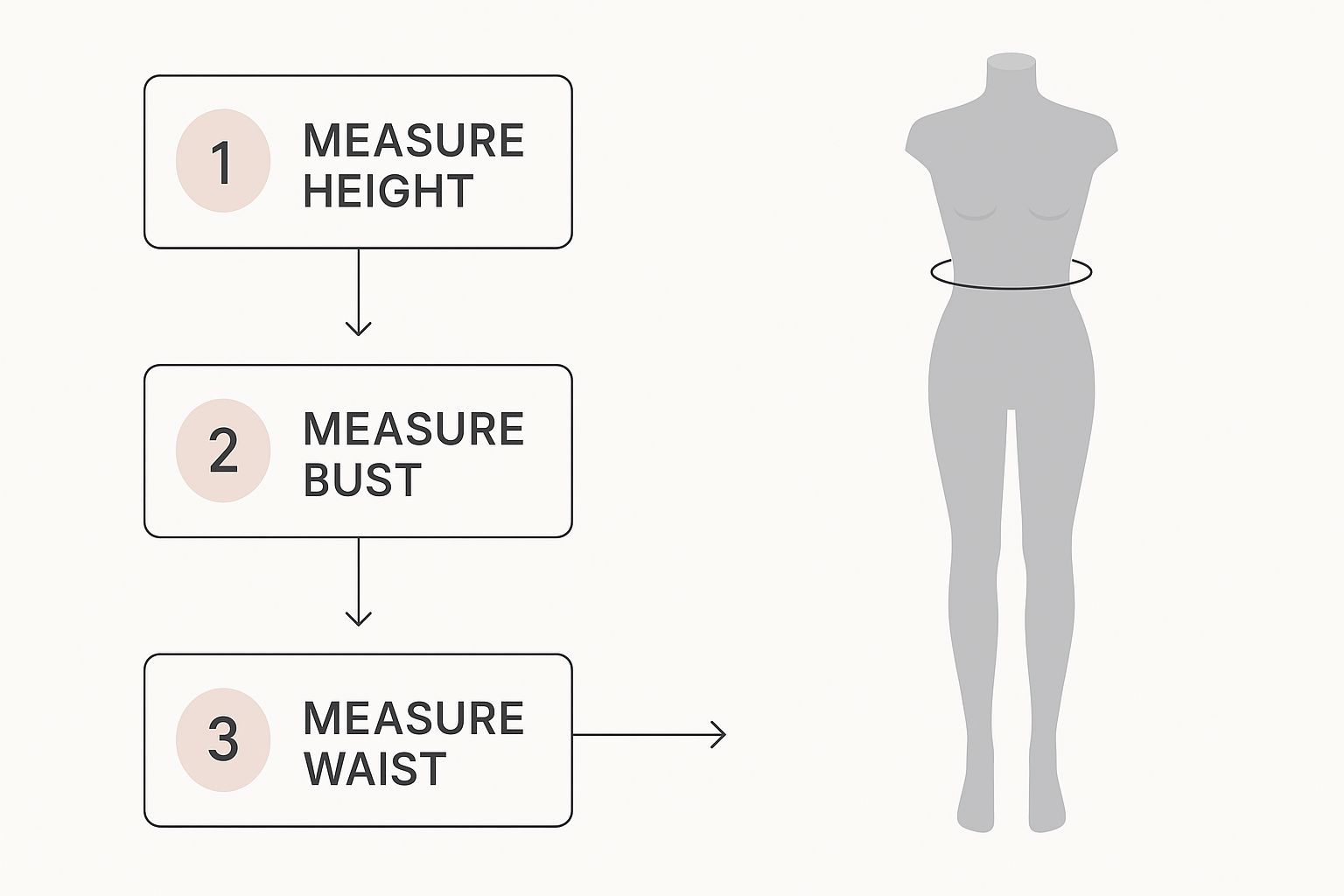
Following this sequence from height down to the waist creates a logical workflow, minimising the chance of errors and making sure you capture all the essential upper-body data efficiently.
Additional Essential Measurements
Beyond the "big three," a few other key dimensions will give you a complete profile of the mannequin’s proportions. This extra detail is vital, especially when you're working with trousers, tailored sleeves, or any close-fitting garments.
Pro Tip: Measuring the inseam can be tricky. I find it’s much easier to lay the mannequin on its side. If you have a model with detachable legs, even better. This gives you clear access and helps you keep the tape perfectly straight from the crotch down to the ankle.
For a truly comprehensive fit assessment, make sure to also capture these figures:
- Shoulder Width: Measure in a straight line across the back, from the bony tip of one shoulder to the other.
- Inseam: Run the tape measure down the inner leg, starting right at the crotch and ending at the bottom of the ankle bone.
- Overall Height: Measure from the highest point of the head straight down to the floor. You'll need to be sure the mannequin is standing perfectly upright on its base for this one.
While these techniques are specific to mannequins, you might find our guide on how to take body measurements for clothes useful for translating these skills to live models.
Female Mannequin Measurements and Size Charts
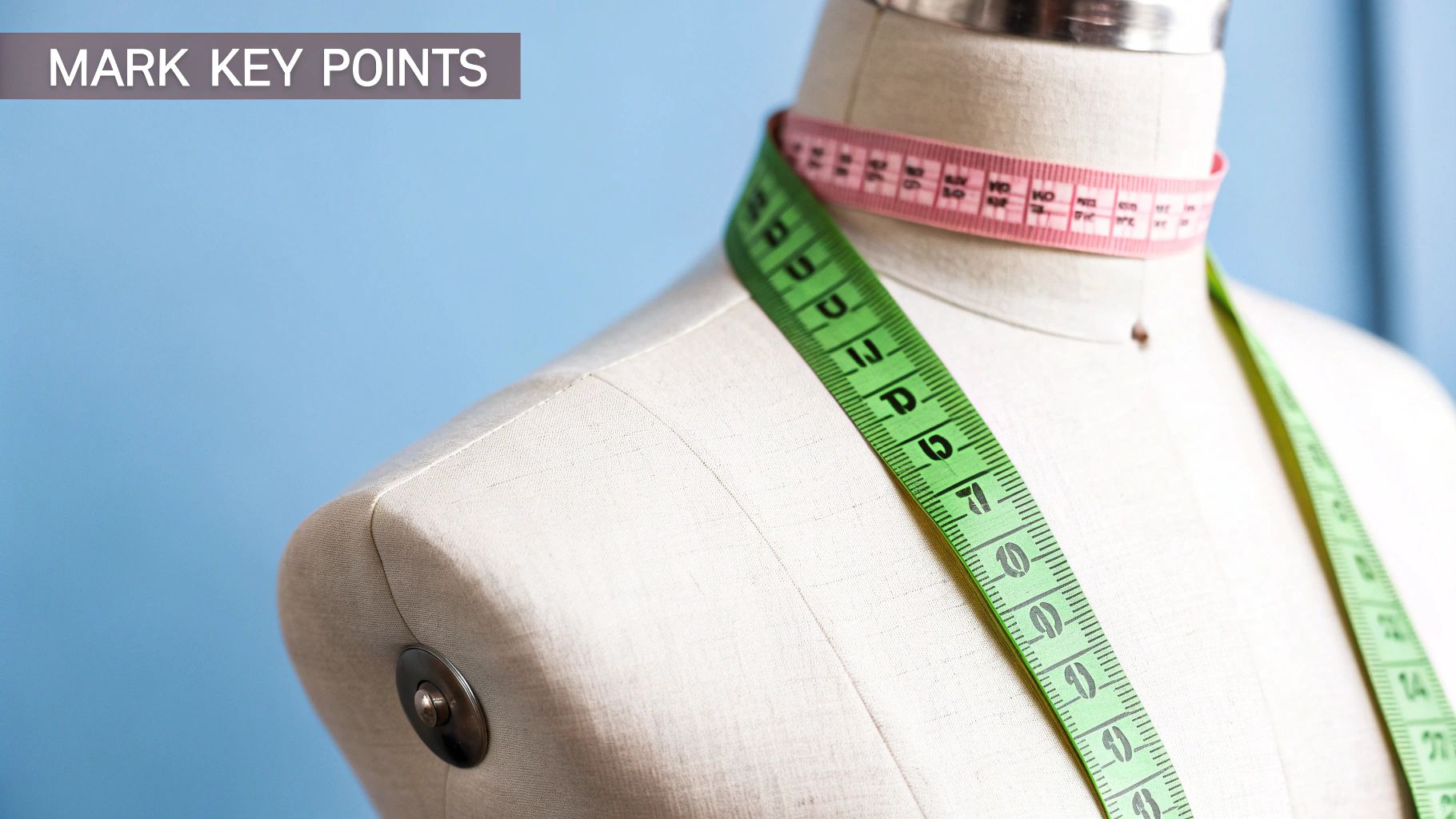
Choosing the right female mannequin goes far beyond just picking a style you like; it’s about understanding the specific measurements that will make your garments look their best. To present your clothing professionally and accurately, you need a form that truly reflects your target customer.
The UK market is filled with a variety of female forms, from the industry-standard models you see in high-street windows to specialised petite and plus-size figures. Each one is built with specific dimensions to suit different clothing lines. This reference will break down the typical mannequin measurements for the most common female forms, so you can confidently match them to your brand's needs. For a detailed look at menswear forms, you might find our tailor dummy male guide useful as well.
Standard Fashion Mannequins: UK Sizes 8-12
Walk into almost any design studio or retail store, and you'll find the standard fashion mannequin. These typically represent a UK size 8, 10, or 12 and are the workhorses of the fashion world. Why? Because their proportions are designed to align perfectly with the sample sizes used by most mainstream brands. They are the default choice for showcasing everything from new dress collections to tailored outerwear.
These mannequins offer a silhouette that is both aspirational and relatable, allowing a broad range of customers to visualise how a garment might fit them. When you're selecting a standard model, pay close attention to the bust, waist, and hip measurements to ensure your core collection drapes just as you intended.
Petite and Plus-Size Mannequin Measurements
Modern retail is all about inclusivity, and that means recognising the diversity of customer body shapes. Specialised mannequins, like petite and plus-size forms, are no longer a niche item; they're essential for brands looking to connect with a wider audience.
- Petite Mannequins (UK Size 6-8): Don't mistake these for simply scaled-down standard models. A true petite mannequin is proportionally shorter, with a height of around 160-165 cm and a shorter torso. This ensures that clothing designed for women 5'3" and under hangs correctly, without bunching or awkward length.
- Plus-Size Mannequins (UK Size 16-20): These forms are absolutely vital for any brand with an extended size range. Featuring fuller bust, waist, and hip measurements, they provide a realistic, flattering representation of how clothing fits a curvier figure. Using them not only builds customer trust but can also help reduce return rates by managing fit expectations.
To help you find the perfect match, the chart below outlines the key measurements for different female mannequin sizes available in the UK.
Comprehensive Female Mannequin Size Chart (UK)
This table provides a detailed breakdown of the standard measurements you can expect for various female mannequin sizes, from petite to plus-size. Use it as a quick reference to compare dimensions and select the form that best aligns with your garment specifications.
| Mannequin Type/Size (UK) | Height (cm) | Bust (cm) | Waist (cm) | Hips (cm) |
|---|---|---|---|---|
| Petite (Size 6) | 162 cm | 81 cm | 61 cm | 86 cm |
| Standard (Size 8) | 175 cm | 84 cm | 63 cm | 89 cm |
| Standard (Size 10) | 178 cm | 88 cm | 65 cm | 90 cm |
| Standard (Size 12) | 180 cm | 92 cm | 70 cm | 95 cm |
| Plus-Size (Size 16) | 182 cm | 102 cm | 84 cm | 109 cm |
| Plus-Size (Size 18) | 182 cm | 107 cm | 89 cm | 114 cm |
Having these figures on hand makes it much easier to ensure a consistent and professional presentation across your entire product range, whether you're fitting in the studio or creating a compelling retail display.
Male and Child Mannequin Size Charts
While female mannequins often get most of the attention, choosing the right male and child forms is just as crucial for creating displays that truly connect with your customers. Menswear and children's clothing have their own specific fitting challenges, and the correct mannequin measurements are the foundation for presenting these garments professionally and accurately.
It's all about catering to your specific audience. A brand focusing on menswear needs a form that reflects standard suit sizing, whereas a children's label has to navigate the rapid growth and changing body shapes across a wide range of age groups. This guide breaks down the key dimensions for both.
Standard Male Mannequin Measurements
The industry benchmark for a standard male mannequin is what's known as a ‘40R’ or a size medium. This size is built around a 40-inch (101.5 cm) chest, which is a very common sample size in the men's fashion world. These mannequins are versatile workhorses, designed to showcase everything from casual t-shirts and jeans to structured suits and formalwear.
When you're sourcing one, here are the key measurements to check:
- Chest: This is the most critical dimension, measured around the fullest part of the chest.
- Waist: Typically corresponds to a 32-inch (81 cm) trouser size.
- Shoulder Width: Absolutely essential for ensuring jackets and shirts hang correctly without pulling or sagging.
- Inseam: This measurement dictates how trousers will break and drape over the shoe.
The table below gives you a clear snapshot of the dimensions for a standard 40R male mannequin.
| Measurement Point | Typical Measurement (cm) | Typical Measurement (inches) |
|---|---|---|
| Height | 185 - 188 cm | 73" - 74" |
| Chest | 101.5 cm | 40" |
| Waist | 81 cm | 32" |
| Hips | 99 cm | 39" |
| Shoulder Width | 48 cm | 19" |
| Inseam | 84 cm | 33" |
Of course, these "standard" dimensions aren't the only option. You'll also find athletic-build mannequins with broader shoulders and a more muscular physique, which are perfect for sportswear brands. And just as with female forms, inclusivity is finally gaining ground in menswear. To see how this is changing retail, you can read our guide on how plus-size mannequins create stylish and inclusive store displays.
Children's Mannequin Measurements by Age Group
Displaying children's clothing well means using mannequins that capture the unique body proportions of different developmental stages. A toddler's posture and shape are worlds away from a teenager's, which is why child mannequin measurements are always categorised by age.
Expert Insight: Don't just look at the numbers; the posture of a child's mannequin is just as important as its measurements. A toddler form with a slightly rounded tummy and a playful, natural stance will make the clothing look far more authentic than a simple scaled-down adult form ever could.
Here’s a practical look at the common age brackets and their typical measurements.
- Toddler Mannequins (Ages 2-4): These forms are specifically sculpted to reflect the shorter, rounder proportions of very young children.
- Child Mannequins (Ages 5-9): As children get a bit older, their bodies start to lengthen and become leaner. These mannequins reflect that shift with longer torsos and limbs.
- Teen Mannequins (Ages 10-16): These models start to resemble adult proportions but are still scaled for a younger, developing frame, making them ideal for junior and teen fashion collections.
This table brings together the key measurements for each age group, helping you select the perfect form for whatever children's apparel you're displaying.
| Mannequin Age Group | Typical Height (cm) | Typical Chest (cm) | Typical Waist (cm) |
|---|---|---|---|
| Toddler (2-4 years) | 90 - 110 cm | 53 - 58 cm | 51 - 55 cm |
| Child (5-9 years) | 115 - 140 cm | 60 - 70 cm | 56 - 62 cm |
| Teen (10-16 years) | 145 - 165 cm | 72 - 82 cm | 63 - 68 cm |
Specialised Mannequin Dimensions for Niche Markets
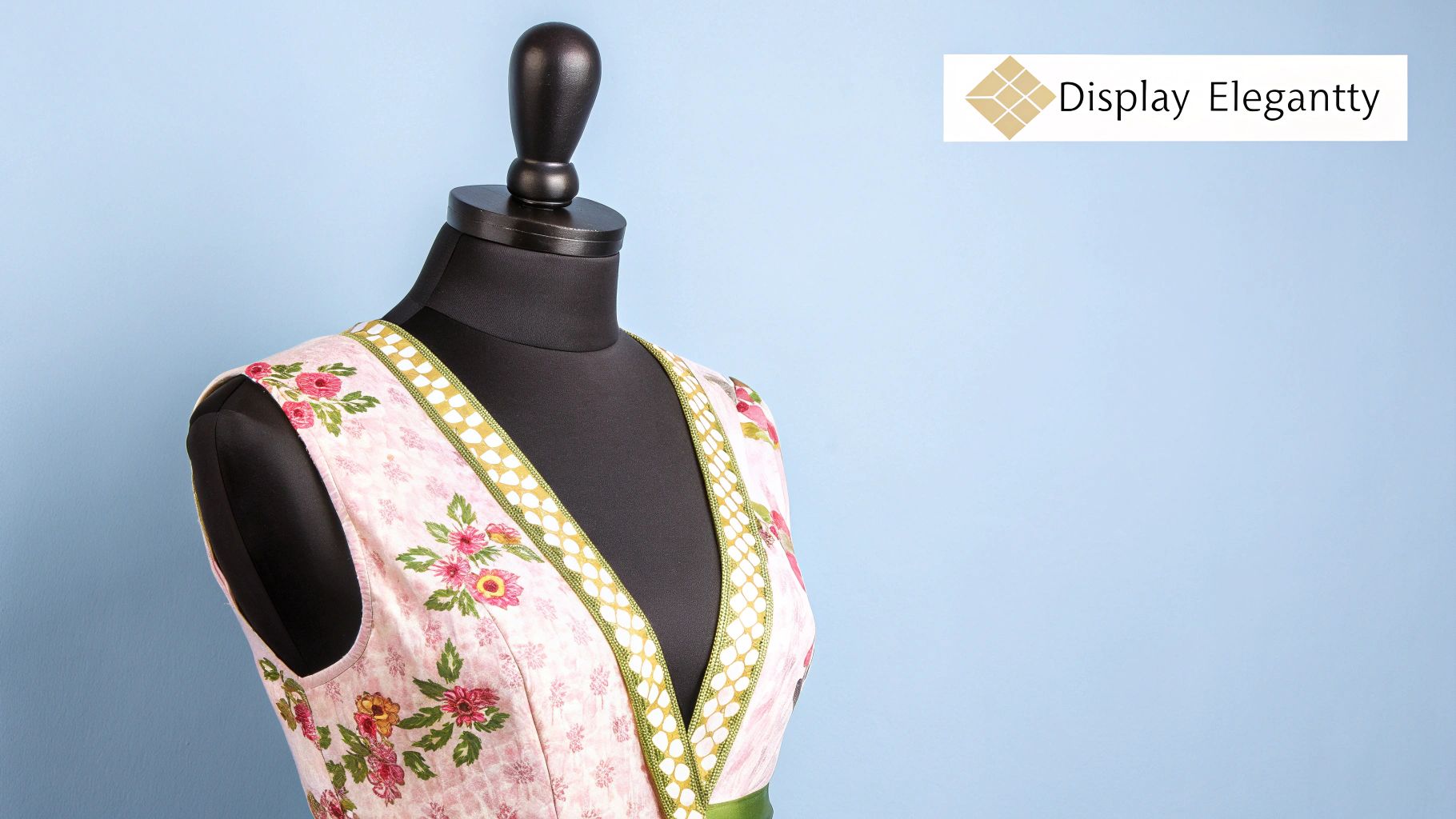
While standard mannequins cover the basics, many fashion niches demand far more specialised forms to display their garments properly. These niche mannequins are carefully engineered with unique mannequin measurements and postures that a typical retail model simply can't match. This ensures that specialised clothing is presented with the intended anatomical accuracy and visual impact.
For businesses in these specific markets—from high-performance sportswear to elegant maternity wear—choosing the right display form is a critical part of the sales process. After all, a standard mannequin can't truly show how athletic wear moves with a toned body or how a maternity dress elegantly drapes over a baby bump. Using the correct specialised form is the only way to do justice to the product's design and fit.
Athletic and Sports Mannequins
Activewear brands need their mannequins to do more than just stand there; they must communicate a sense of energy and movement. Sports mannequins are sculpted with well-defined musculature and are often posed in dynamic positions like running, jumping, or stretching. This isn't just for show—it serves a very practical purpose.
These forms are built with specific measurements to accommodate performance apparel:
- Broader Shoulders: Vital for correctly fitting rash guards, compression tops, and sports jackets without stretching the fabric unnaturally.
- Defined Leg Musculature: Essential for demonstrating how leggings, shorts, and performance trousers fit over athletic thighs and calves.
- Athletic Waist-to-Hip Ratio: The silhouette is often straighter than that of standard forms, reflecting a more athletic build.
The history of mannequin design in the UK reflects a fascinating evolution. Post-war manufacturers favoured idealised, slender figures, but by the 1980s, a clear shift towards more realistic and average body sizes began, driven by a growing call for inclusivity. You can explore this balance between artistic form and commercial reality in the historical development of UK mannequin design.
Lingerie and Maternity Forms
Lingerie and maternity wear are two sectors where precise, specialised mannequin measurements are absolutely non-negotiable for creating an effective display.
A well-chosen mannequin speaks directly to your target customer. For maternity wear, a form with a realistic bump instantly creates a connection and helps expectant mothers visualise the fit and comfort of the garment.
- Lingerie Mannequins: These forms are sculpted with highly accurate and often more detailed bust shapes to ensure bras and delicate items fit flawlessly. The under-bust and cup-size dimensions are critical, offering a far superior representation than a standard mannequin ever could.
- Maternity Mannequins: The defining characteristic is the realistically sculpted baby bump. These are often available in different trimesters to show how clothing adapts to a growing belly, featuring an expanded waistline and fuller hips.
Whether you're working with delicate lace or a structured wedding gown, the fundamental principles of accurate measurement are universal. For anyone involved in custom garment creation, our ultimate fitting guide for an adjustable mannequin offers complementary insights that can significantly improve your fitting process.
How to Choose the Right Mannequin Size for Your Brand
Picking the right mannequin is far more than just a matter of aesthetics; it's a critical business decision. The measurements you select directly influence how customers see your clothing, which in turn affects everything from visual appeal right through to your sales figures. Think of your mannequin as a silent ambassador for your brand—its form needs to perfectly reflect your target customer and brand identity.
The first and most important step is to understand your core customer. Take a good look at your sales data to pinpoint your best-selling sizes. For example, if your brand consistently sells a high volume of UK sizes 10-14, using a standard size 8 mannequin won't give a true representation of how your clothes actually fit the majority of your buyers. The aim is to align the mannequin's dimensions as closely as possible with your key demographic.
Aligning Mannequin Style with Brand Identity
Beyond the pure numbers, the style of the mannequin itself plays a huge part in telling your brand's story. The choice you make should reinforce what your brand stands for. Are you a high-fashion house or a high-street staple?
- Realistic Mannequins: With lifelike faces, natural poses, and familiar proportions, these help shoppers picture themselves wearing the outfits. This makes them perfect for relatable, everyday fashion brands.
- Abstract Mannequins: These feature stylised, often featureless forms in neutral colours like black or white. They create a more artistic, high-concept atmosphere, drawing all the focus to the garment’s silhouette and fabric. This style is well-suited to luxury or avant-garde labels.
The pose you choose is another vital element. A dynamic, active pose is brilliant for sportswear, as it conveys a sense of energy and movement. On the other hand, a classic, static pose suggests timeless elegance, making it ideal for formalwear or tailored pieces. The way a mannequin stands can completely change how a garment drapes and hangs. You can find out more about setting up your displays in our complete guide to using a mannequin with a stand.
Choosing a mannequin is truly an exercise in brand strategy. A luxury brand might opt for a slender, abstract form to create an aspirational mood, whereas a family-focused retailer would benefit from a range of inclusive sizes that reflect real customers.
The history of mannequin measurements in the UK has been a long journey, shaped by both technology and changing social values. Immediately after the Second World War, resource rationing resulted in smaller, heavier mannequins made from wood and wax. The post-war economic boom brought lighter plastic models, and by 2019, a UK company launched the first gender-neutral mannequin, highlighting the industry’s shift towards greater inclusivity. This evolution from rigid, idealised forms to diverse representation mirrors profound changes in the retail world. You can read more about the fascinating history of shop mannequins.
Answering Your Questions About Mannequin Sizing
Choosing the right mannequin involves more than just aesthetics; getting the measurements right is crucial for anyone in retail or fashion design. Below, we’ve answered some of the most common questions we hear from designers, retailers, and sewing professionals to help you make a more confident and informed choice.
Think of it this way: the right mannequin isn't just a display piece, it's a vital tool for communicating fit and style. Matching the correct dimensions to your collection is the first step.
What is the Standard Mannequin Size in the UK?
In the UK fashion industry, the go-to standard for a female mannequin is typically a size 8 or 10. This size has long been the baseline for creating sample garments and is what you'll most often see in general retail displays.
For menswear, the standard is usually a ‘40R’ mannequin. This translates to a 40-inch chest paired with a waist that's generally around 32 inches. These measurements reflect a common sample size used across the board for men's apparel.
How Do UK Mannequin Sizes Compare to US Sizes?
There’s a handy rule of thumb for a quick conversion, but it comes with a strong caveat. As a general guide, a UK clothing size is two numbers smaller than its American counterpart.
So, a UK size 10 mannequin is broadly equivalent to a US size 6. However, this is just an estimate. For any serious design or fitting work, you absolutely must rely on the specific bust, waist, and hip measurements in either centimetres or inches. Sizing can vary wildly from one brand to another, so the tape measure is always your most reliable source of truth.
Are Realistic or Abstract Mannequins Better?
This is a classic question, but the truth is, neither is "better." The best choice is the one that aligns with your brand's identity and the story you want to tell. They simply serve different strategic purposes.
- Realistic Mannequins: With their lifelike features and natural poses, these mannequins help customers truly see themselves wearing the clothes. They're perfect for high-street brands that want to create a relatable, approachable feel.
- Abstract Mannequins: These forms are all about simplicity. Their stylised shapes and neutral finishes ensure nothing distracts from the garment’s silhouette, fabric, and construction. This makes them a favourite for luxury labels and artistic, high-fashion brands.
Ultimately, it all comes down to your brand’s narrative. A realistic mannequin says, "This could be you," while an abstract one declares, "This is art."
Why Are Plus-Size Mannequin Measurements Important?
Including plus-size mannequins in your display strategy is fundamental for building an inclusive and realistic retail space. For any brand that serves a diverse customer base, they are non-negotiable. They accurately show how clothing fits and drapes on a larger, more representative body shape.
This kind of authentic representation is incredibly powerful. It not only helps customers feel confident in their purchasing decisions but also sets clear expectations about fit, which can significantly reduce return rates. Most importantly, it sends a clear message that a wider community of shoppers is seen, valued, and catered for by your brand.
For all your display needs, from tailor's dummies to garment rails, explore the professional collection at Display Guru. Find the perfect fit for your brand.
